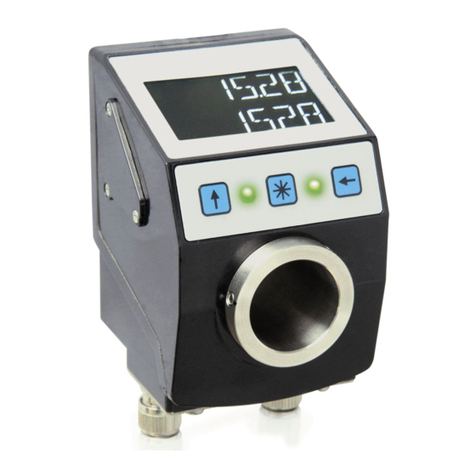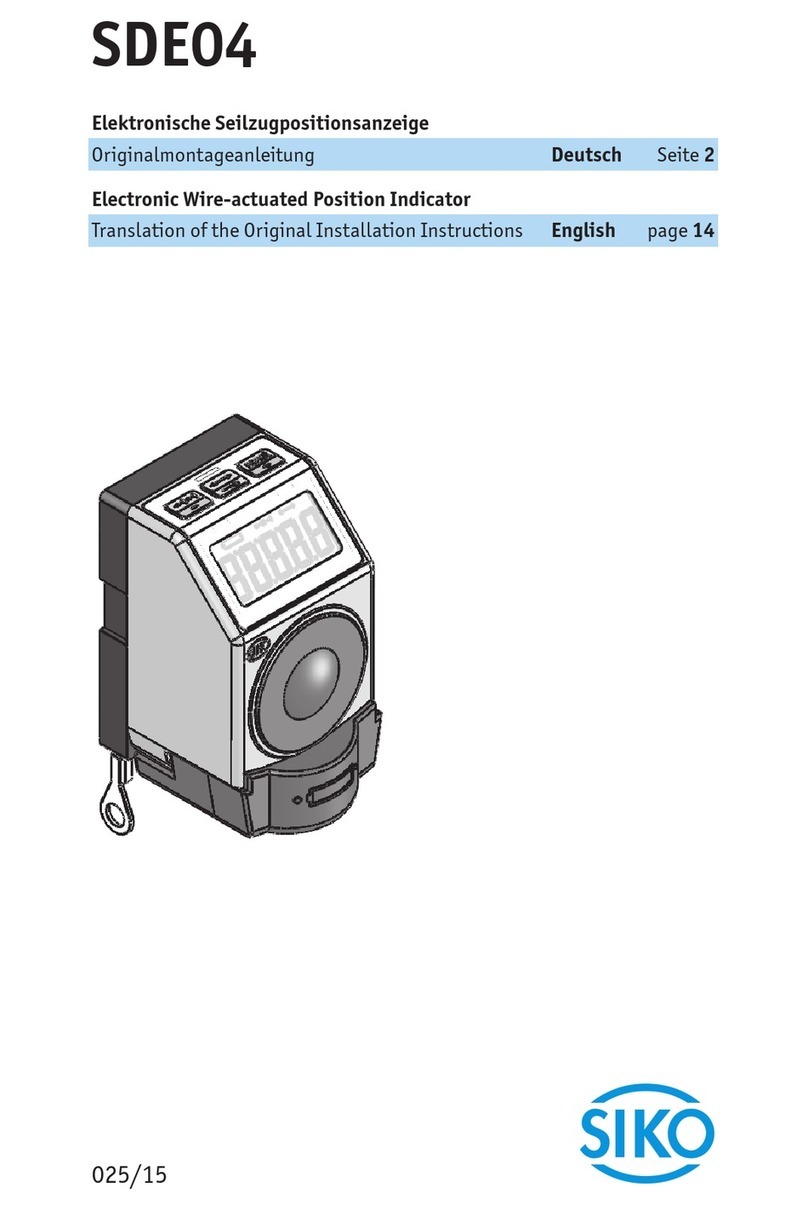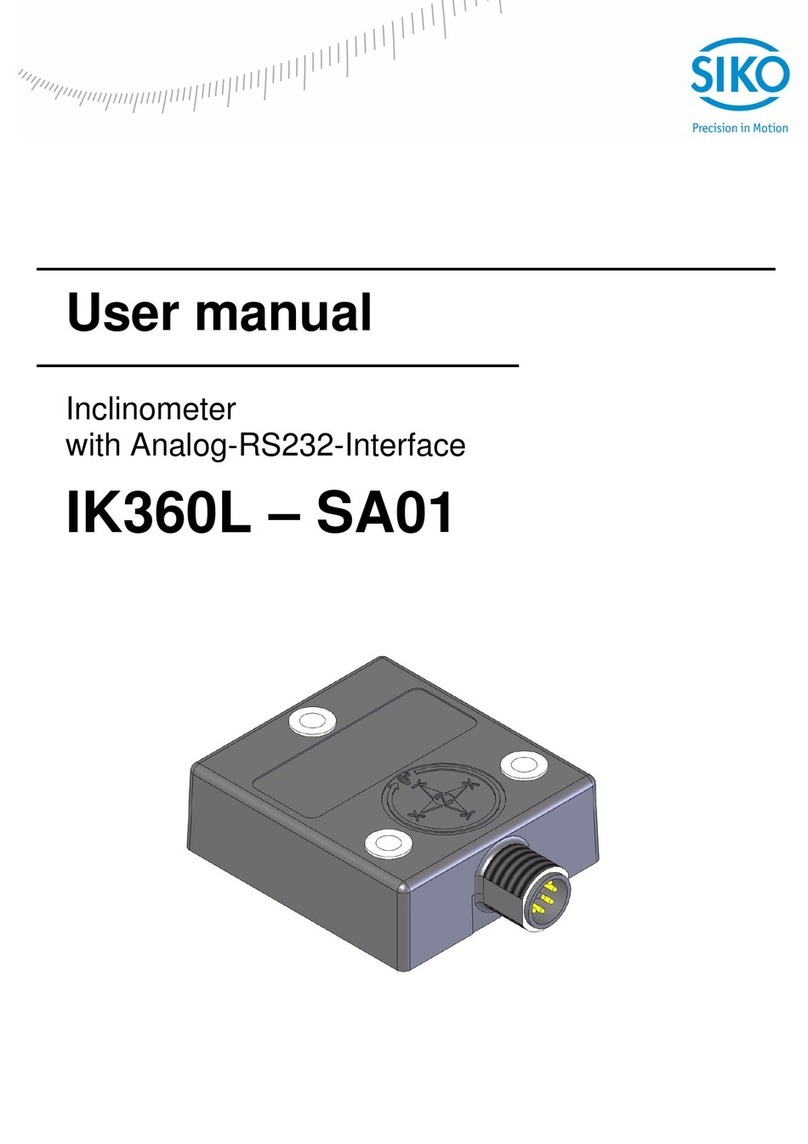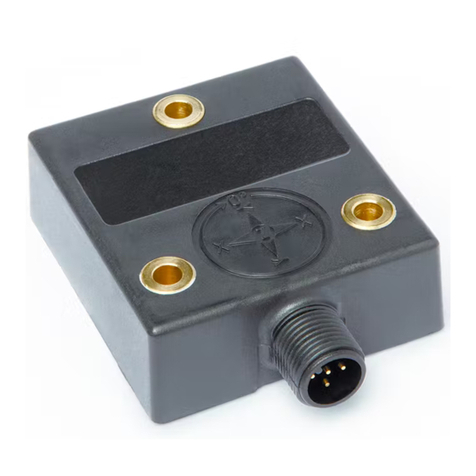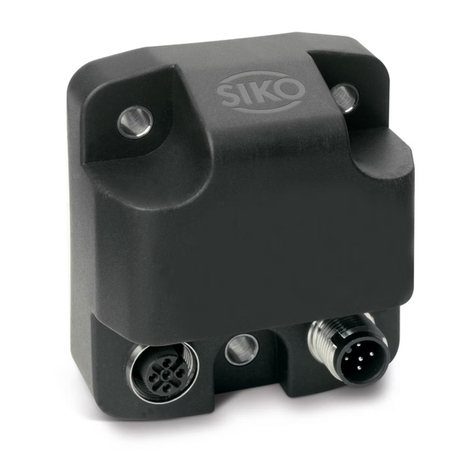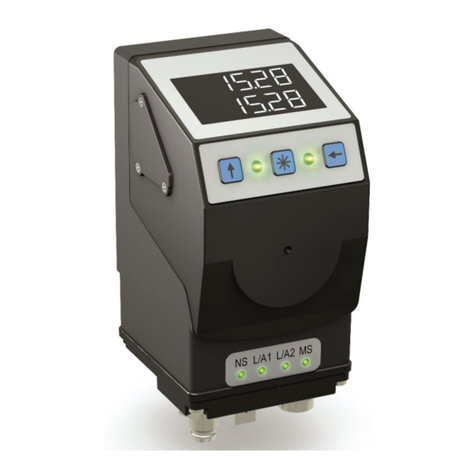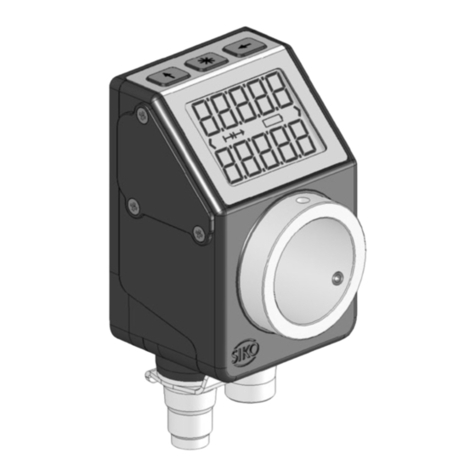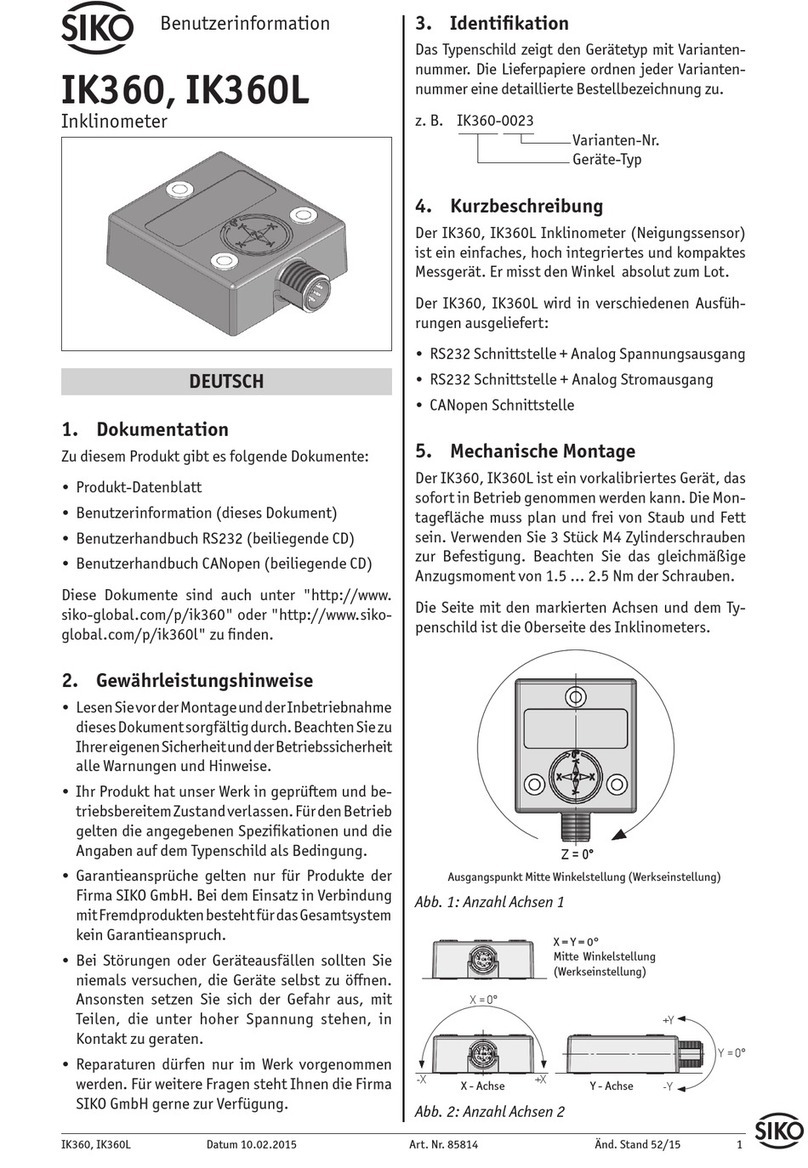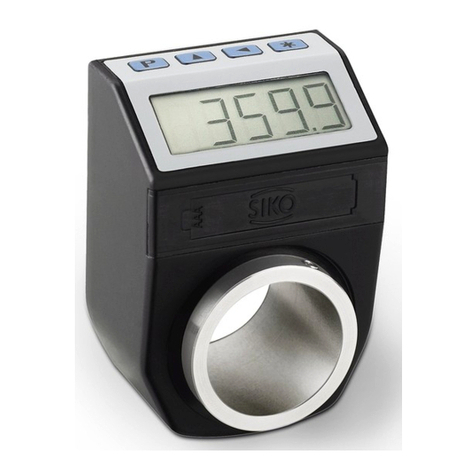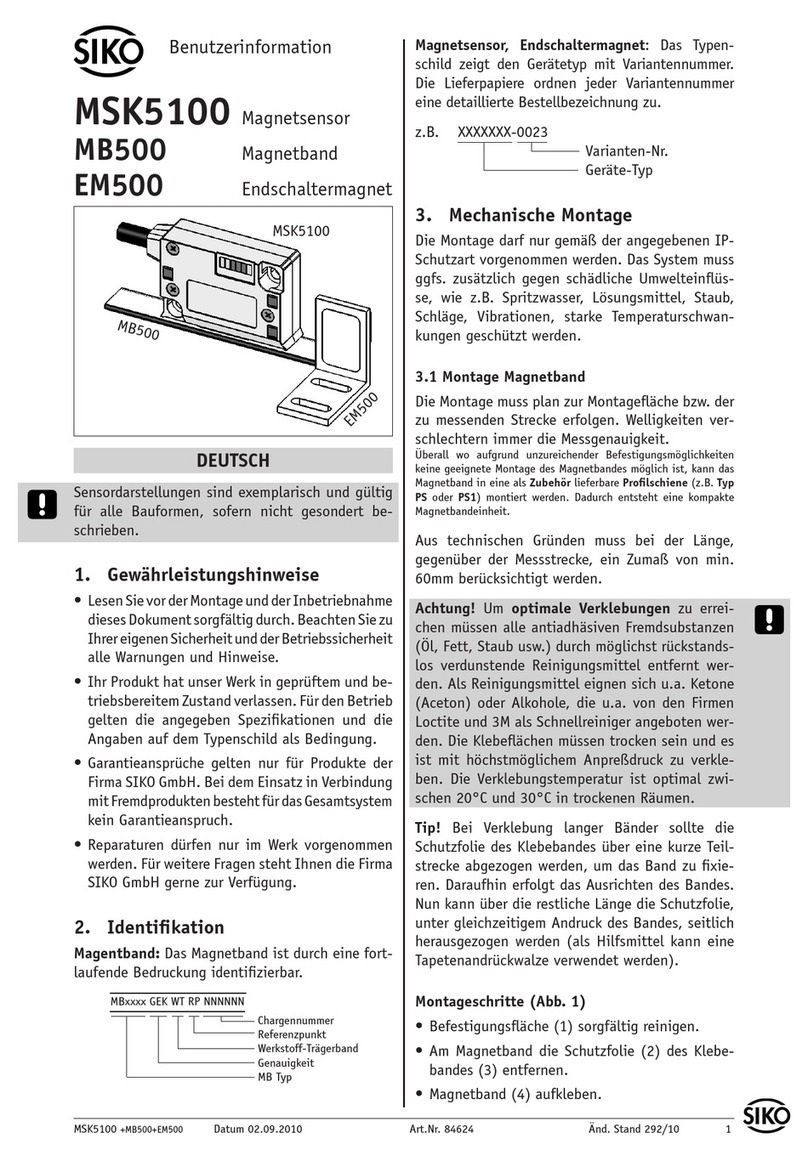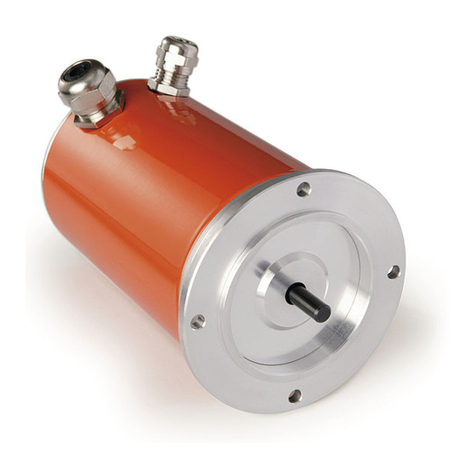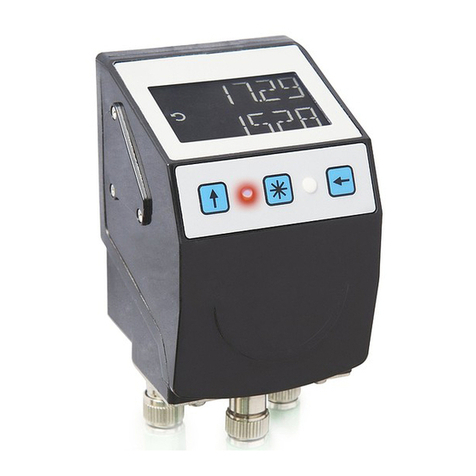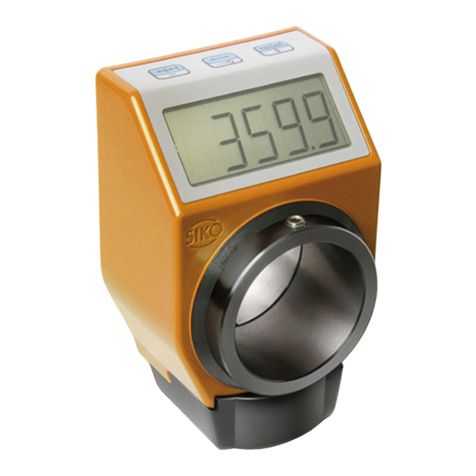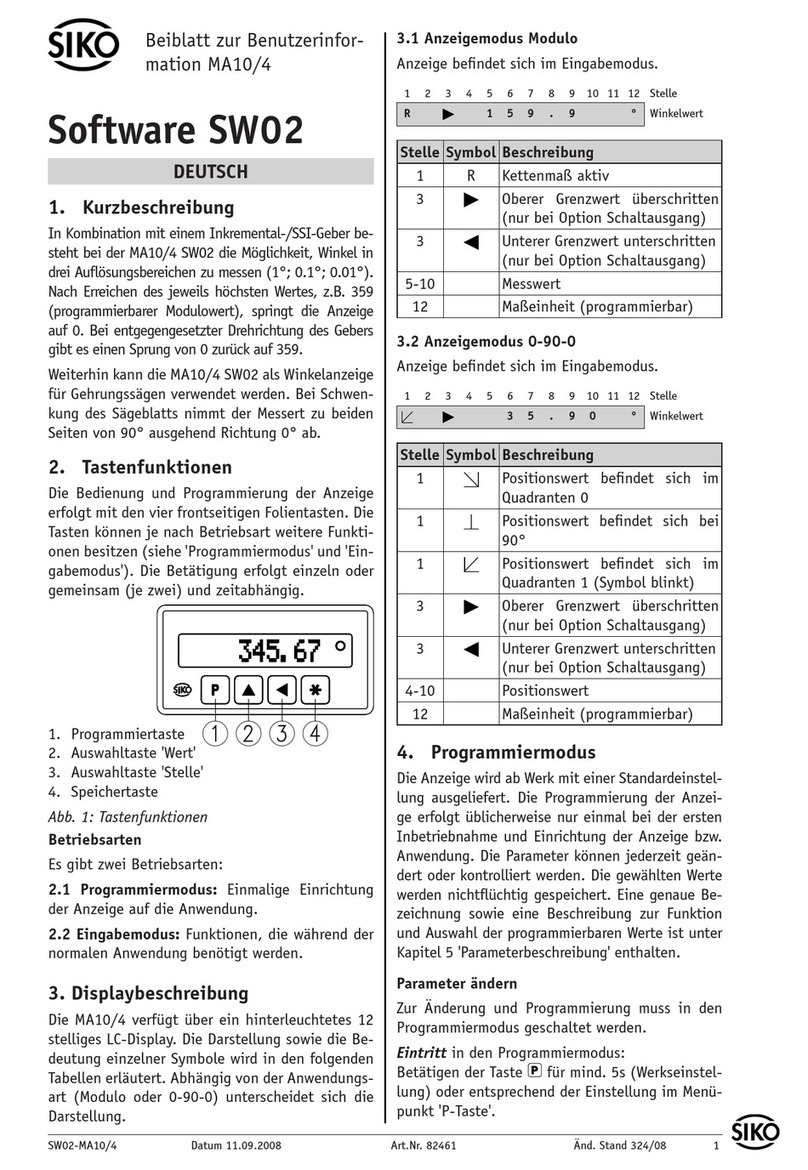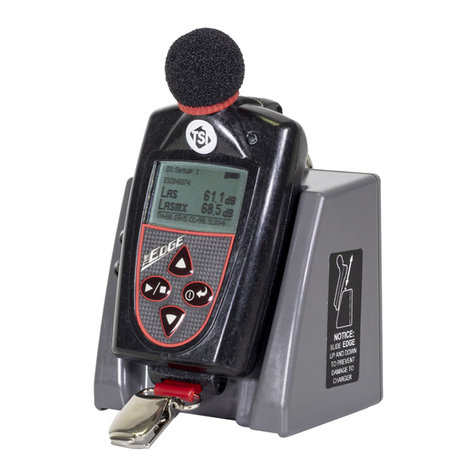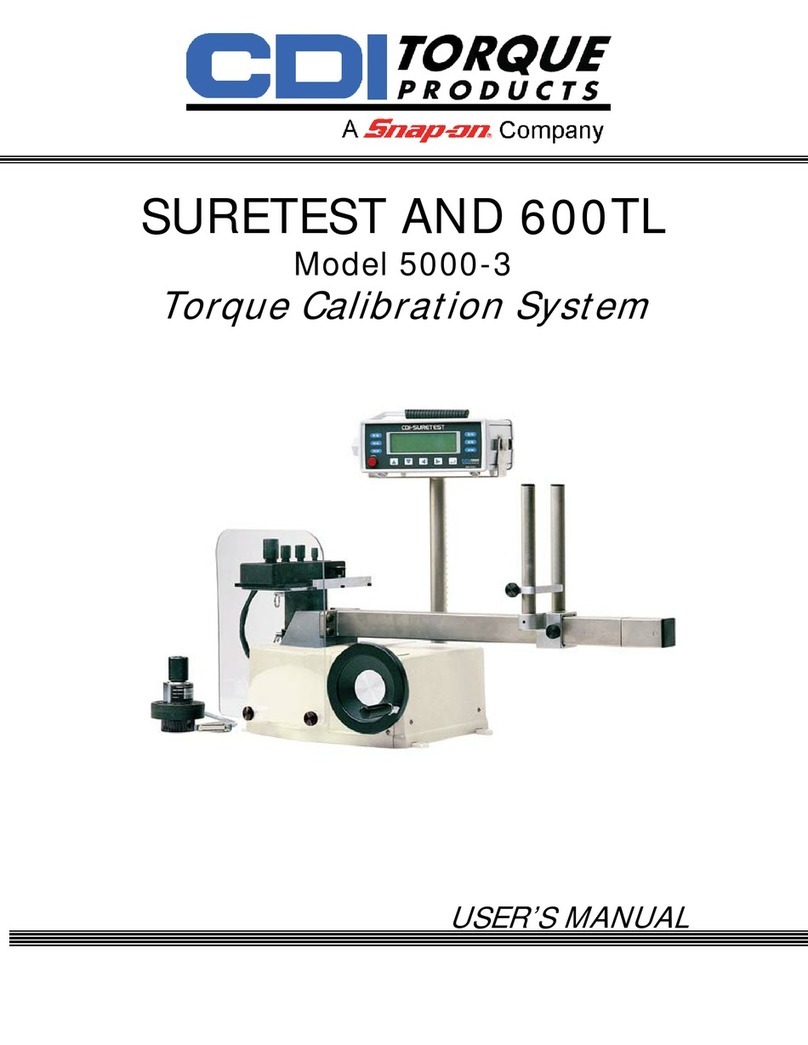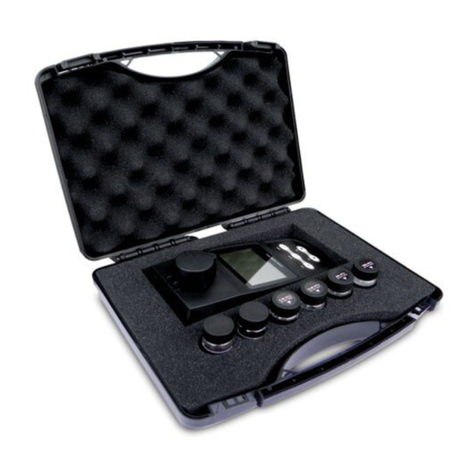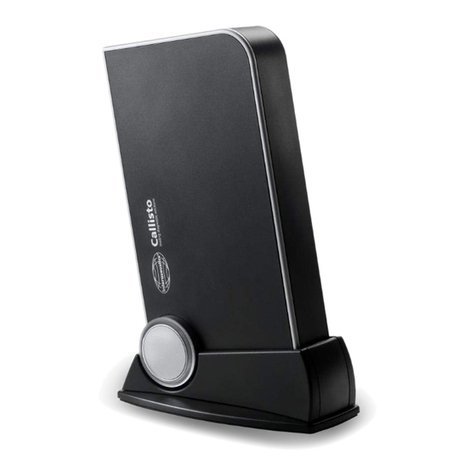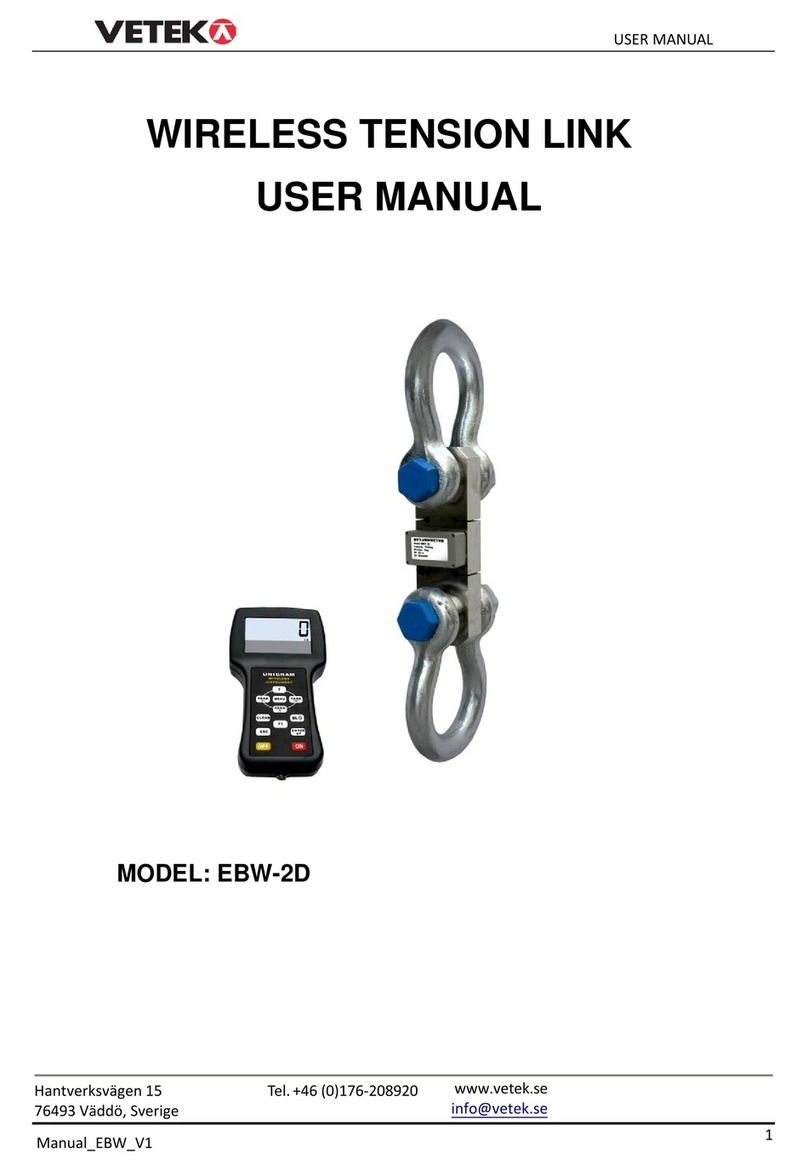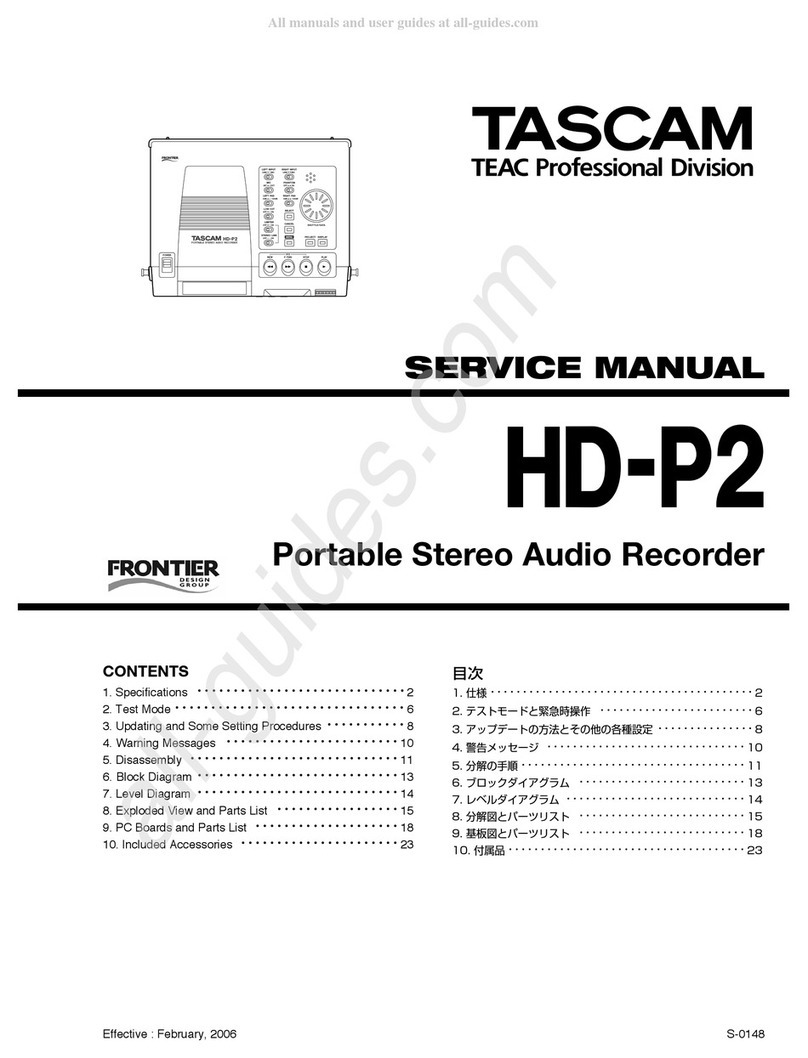Siko LE200 + MB200 Operation manual

LE200+MB200 Datum 09.11.2009 Art.Nr. 84882 Änd. Stand 326/09 1
Benutzerinformation
LE200 + MB200
Magnetsensor und Magnetband
DEUTSCH
Sensordarstellungen sind exemplarisch und gültig
für alle Bauformen, sofern nicht gesondert be-
schrieben.
1. Gewährleistungshinweise
Lesen Sie vor der Montage und der Inbetriebnahme
dieses Dokument sorgfältig durch. Beachten Sie zu
Ihrer eigenen Sicherheit und der Betriebssicherheit
alle Warnungen und Hinweise.
Ihr Produkt hat unser Werk in geprüftem und be-
triebsbereitem Zustand verlassen. Für den Betrieb
gelten die angegeben Spezifikationen und die
Angaben auf dem Typenschild als Bedingung.
Garantieansprüche gelten nur für Produkte der
Firma SIKO GmbH. Bei dem Einsatz in Verbindung
mit Fremdprodukten besteht für das Gesamtsystem
kein Garantieanspruch.
Reparaturen dürfen nur im Werk vorgenommen
werden. Für weitere Fragen steht Ihnen die Firma
SIKO GmbH gerne zur Verfügung.
2. Identifikation
Magnetband: Das Magnetband ist durch eine fort-
laufende Bedruckung identifizierbar.
Beispiel Magnetbandbedruckung:
•
•
•
•
ordnen jeder Variantennummer eine detaillierte
Bestellbezeichnung zu.
z.B. LE200-0023
Varianten-Nr.
Geräte-Typ
3. Mechanische Montage
Die Montage darf nur gemäß der angegebenen IP-
Schutzart vorgenommen werden. Das System muss
ggfs. zusätzlich gegen schädliche Umwelteinflüs-
se, wie z.B. Spritzwasser, Lösungsmittel, Staub,
Schläge, Vibrationen, starke Temperaturschwakun-
gen geschützt werden.
3.1 Montage Magnetband
Die Montage muss plan zur Montagefläche bzw. der
zu messenden Strecke erfolgen. Welligkeiten ver-
schlechtern immer die Messgenauigkeit.
Aus technischen Gründen muss bei der Länge,
gegenüber der Messstrecke, ein Zumaß von min.
55mm berücksichtigt werden.
Achtung! Um optimale Verklebungen zu errei-
chen müssen alle antiadhäsiven Fremdsubstanzen
(Öl, Fett, Staub usw.) durch möglichst rückstands-
los verdunstende Reinigungsmittel entfernt wer-
den. Als Reinigungsmittel eignen sich u.a. Ketone
(Aceton) oder Alkohole, die u.a. von den Firmen
Loctite und 3M als Schnellreiniger angeboten wer-
den. Die Klebeflächen müssen trocken sein und es
ist mit höchstmöglichem Anpreßdruck zu verkle-
ben. Die Verklebungstemperatur ist optimal zwi-
schen 20°C und 30°C in trockenen Räumen.
Tip! Bei Verklebung langer Bänder sollte die
Schutzfolie des Klebebandes über eine kurze Teil-
strecke abgezogen werden, um das Band zu fixie-
ren. Daraufhin erfolgt das Ausrichten des Bandes.
Nun kann über die restliche Länge die Schutzfolie,
unter gleichzeitigem Andruck des Bandes, seitlich
herausgezogen werden (als Hilfsmittel kann eine
Tapetenandrückwalze verwendet werden).
Montageschritte (Abb. 1)
Befestigungsfläche (1) sorgfältig reinigen.
Am Magnetband die Schutzfolie (2) des Klebe-
bandes (3) entfernen.
Magnetband (4) aufkleben. Aktive Fläche nach
oben, erkennbar am Aufdruck.
Magnetbandoberfläche sorgfältig reinigen.
Am Abdeckband (5) die Schutzfolie (6) des Kle-
bebandes entfernen.
Abdeckband aufkleben (an beiden Enden leicht
überlappen lassen).
Die überlappenden Enden des Abdeckbandes gegen
Ablösen sichern.
•
•
•
•
•
•
•
Polbreite: 2mm
Bandgenauigkeit: 0,02mm
Seriennummer
0
0
2
NNNN 0200
Magnetsensor: Das Typenschild zeigt den Ge-
rätetyp mit Variantennummer. Die Lieferpapiere

2 LE200+MB200 Datum 09.11.2009 Art.Nr. 84882 Änd. Stand 326/09
Abb. 2 Abb. 3
Abb. 4 Abb. 5
Abb. 1: Montage Magnetband
2
1
3
4
5 6
Abb. 6: Definition der Zählrichtung
Verfahrrichtung Sensor,
Sinus vor Cosinus
Kabelabgangs-
richtung
Abstand Sensor/Magnetband
Maximale Fluchtungsfehler
< 1°
< 3°
(<1°*)
aktive
Seite
Kabelabgangs-
richtung
±0.5
< 3°
(<1°*)
* bei Referenz-
signal "RB"
Referenzpunktlage zur
Magnetbandbedruckung
0,1mm ... 0,8mm
ohne Referenzpunkt
0,1mm ... 0,5mm
mit Referenzpunkt
0
0
2
NNNN 0200
Achtung! Die Beeinflussung durch magnetische
Felder ist zu vermeiden. Insbesondere dürfen keine
Magnetfelder (z.B. Haftmagnete oder andere Dauer-
magnete) in direkten Kontakt mit dem Magnetband
geraten. In stromlosem Zustand werden Bewegun-
gen oder Verstellungen des Magnetsensors von der
Folgeelektronik nicht erkannt und erfaßt.
Montagebeispiele
Die einfache Montageart, durch angeschrägtes
Schutzband (Abb. 2), ist nur in sehr geschützter Um-
gebung zu empfehlen. Bei ungeschützer Umgebung
besteht Abschälgefahr. In solchen Fällen sind Mon-
tagearten, wie in Abb. 3 und 4 gezeigt, geeigneter.
Den optimalen Schutz bietet die Montage in einer
Nut (Abb. 5), die so tief sein sollte, dass das Mag-
netband vollständig darin eingebettet werden kann.
Magnetband legen. Hinweis: Betrifft nur Sensoren
ohne Referenzsignal R.
3.3. Montage Magnetsensor
Der Magnetsensor LE200 kann durch Verwendung
von 2 Schrauben über die Langlöcher befestigt
werden. Es wird empfohlen die beiliegenden Be-
festigungsschrauben und Federringe zu verwenden
(Anzugsmoment 1Nm).
Kabel sind so zu verlegen, dass keine Beschädigungs-
gefahr durch Zug oder andere Maschinenteile be-
steht. Falls nötig Schleppkette oder Schutzschlauch
verwenden und Zugentlastung vorsehen.
Auf richtige Ausrichtung bezüglich der Zähl-
richtung achten (Abb. 6). Dies ist unerheblich
falls sich die Zählrichtung in der elektronischen
Auswertung umkehren läßt.
Abstandslehre vollflächig zwischen Sensor und
•
•
•
Abstandmaße zwischen Sensor und Magnetband
sowie Winkeltoleranzen beachten, diese müssen
über die gesamte Messstrecke eingehalten werden
(siehe Abb. 7)!
Der maximale Abstand zwischen Sensorkopf und
Magnetband ohne Abdeckband beträgt 0,8mm
(mit Referenzpunkt max. 0,5mm). Bei Verwen-
dung eines Abdeckbandes reduziert sich der
eff. Abstand um die Dicke des Abdeckbandes
inkl. Klebefolie. Der Sensor darf das Magnet-
band nicht berühren.
•

LE200+MB200 Datum 09.11.2009 Art.Nr. 84882 Änd. Stand 326/09 3
Abb. 7: Definition der Zählrichtung mit Magnetband und
Montage Sensor/Magnetband, Abstandsmaße, Toleranzen
Lage Ref.Punkt P=entspr. Lieferpapiere
Lage Ref.Punkt E=entspr. Lieferpapiere
min. 0,05m
Symbolische Dar-
stellung der Pole Einmaliger Referenzpunkt
Referenzpunkt periodisch
50
so kurz wie
möglich
Schirm
5
Ansichtseite =
Steckseite
Schirm
Schirm
Buchsenteil
Stiftteil
4. Elektrischer Anschluss
Vor dem Einschalten sind alle Leitungsanschlüsse
und Steckverbindungen zu überprüfen.
Hinweise zur Störsicherheit
Alle Anschlüsse sind gegen äußere Störeinflüsse
geschützt. Der Einsatzort ist aber so zu wählen,
dass induktive oder kapazitive Störungen nicht
auf den Sensor oder dessen Anschlussleitung
einwirken können! Durch geeignete Kabelfüh-
rung und Verdrahtung können Störeinflüsse (z.B.
von Schaltnetzteilen, Motoren, getakteten Reg-
lern oder Schützen) vermindert werden.
Erforderliche Maßnahmen:
Das System muss in möglichst großem Abstand von
Leitungen eingebaut werden, die mit Störungen
belastet sind; ggfs. sind zusätzliche Maßnahmen
wie Schirmbleche oder metallisierte Gehäuse
vorzusehen. Leitungsführungen parallel zu Ener-
gieleitungen vermeiden.
Schützspulen müssen mit Funkenlöschgliedern
beschaltet sein.
Spannungsversorgung
Die Spannungswerte sind abhängig von der Sen-
sorausführung und sind den Lieferpapieren sowie
dem Typenschild zu entnehmen.
z.B.: 5VDC
4.1 Anschlussarten
E1: Anschluss mit offenen Kabelenden.
Achtung! Verzinnte Litzen dürfen nicht in Verbindung
mit Schraubklemmverbindungen eingesetzt werden.
•
•
•
E6: Anschluss mit Kupplungsstecker und Kupp-
lungsdose.
Pos. 6 ... 10 über Kabelmantel schieben.
Kabel abisolieren.
Schirm umlegen.
Pos. 5 auf Litzen schieben.
Kabel an Pos. 3 löten (entspr. Anschlussplan).
Abstandhülse Pos. 4 aufweiten und über Litzen
stülpen, zusammendrücken und auf Pos. 3 ste-
cken. Schlitz und Nut (Pos. 3 und 4) müssen
deckungsgleich sein.
Pos. 6 an Pos. 5 drücken, überstehender Schirm
abschneiden.
Pos. 2 und 7 aufschieben und mittels Montage-
werkzeug Pos. 11 verschrauben.
Pos. 8 in Pos. 9 stecken, beides in Pos. 7
schieben.
Pos. 10 mit Pos. 7 verschrauben.
Pos. 1 in Pos. 2 schieben.
1.
2.
3.
4.
5.
6.
7.
8.
9.
10.
11.
4.2 Anschlussbelegung
Ohne Referenzsignal (7-pol. Stiftkontakt)
PIN Kabelfarbe Signal
1 schwarz GND
2 rot sin
3 orange /sin
4 gelb cos
5 grün /cos
6 braun +UB
7 - - - - - -

4 LE200+MB200 Datum 09.11.2009 Art.Nr. 84882 Änd. Stand 326/09
A B C D
Ansichtseite =
Steckseite
Mit Referenzsignal (8-pol. Stiftkontakt)
PIN Kabelfarbe Signal
1 rot sin
2 gelb cos
3 blau index
4 braun +UB
5 schwarz GND
6 orange /sin
7 grün /cos
8 violett /index
5. Inbetriebnahme
Nach ordnungsgemäßer Montage und Verdrahtung
kann das Messsystem durch Einschalten der Ver-
sorgungsspannung in Betrieb genommen werden.
Das Gerät initialisiert sich selbstständig nach den
Einschalten.
Beim Verfahren des Sensors über das Magnetband
blinken die Leuchtdioden nach folgendem Schema:
LED Farbe Funktion
A grün Power
B rot Aktiv wenn cos < /cos
C rot Aktiv wenn sin < /sin
D rot Aktiv wenn /ref < ref
6. Wartung
Die Oberfläche des Magnetbandes ist bei starker
Verschmutzung durch Staub, Späne, Feuchtigkeit,
usw., von Zeit zu Zeit mit einem weichen Lappen
zu reinigen.
7. Fehlerbehandlung
Typische Fehler, die bei Anbau und Betrieb auf-
treten:
Das Magnetband wurde falsch montiert /aktive
Seite nach unten (s. Kap. 3.1).
Der Sensor ist nicht korrekt angeschlossen. An-
schluss überprüfen.
Die Abstandstoleranz zwischen Sensor und
•
•
•
Magnetband wurde nicht über die gesamte
Messstrecke eingehalten, der Sensor streift auf
dem Magnetband (Abb. 7).
Kabelunterbrechung / Abtrennung durch scharfe
Kanten / Quetschung.
Der Sensor ist mit der aktiven Seite vom Band
abgewandt montiert (Abb. 7).
Der Sensor wurde nicht entsprechend Abb. 6+7
ausgerichtet.
•
•
•

LE200+MB200 Datum 09.11.2009 Art.Nr. 84882 Änd. Stand 326/09 5
User Information
LE200 + MB200
Magnetic sensor and magnetic strip
ENGLISH
Exemplary sensor illustrations are valid for all sen-
sor types unless described separately.
1. Warranty information
In order to carry out installation correctly, we
strongly recommend this document is read very
carefully. This will ensure your own safety and
the operating reliability of the device.
Your device has been quality controlled, tested
and is ready for use. Please observe all warnings
and information which are marked either directly
on the device or specified in this document.
Warranty can only be claimed for components
supplied by SIKO GmbH. If the system is used
together with other products, there is no warranty
for the complete system.
Repairs should be carried out only at our works.
If any information is missing or unclear, please
contact the SIKO sales staff.
2. Identification
Magnetic strip: identification by printing on the
strip. Example Magnetic strip printing:
•
•
•
•
e.g. LE200-0023
version number
type of unit
3. Installation
For mounting, the degree of protection specified
must be observed. If necessary, protect the unit
against environmental influences such as sprayed
water, dust, knocks, extreme temperatures.
3.1 Mounting the magnetic strip
The mounting surface/measuring track must be
flat. Buckles or bumps will lead to measuring in-
accuracies.
For technical reasons the strip should be min.
55mm longer than the actual measuring distance.
Attention! To guarantee optimal adhesion oil,
grease dust etc. must be removed by using clean-
sing agents which evaporate without leaving re-
sidues. Suitable cleansing agents are eg. ketones
(acetone) or alcohols; Messrs. Loctite and 3M can
both supply such cleansing liquid. Make sure that
the surface to be glued is dry and apply the strip
with maximum pressure. Glueing should preferably
be undertaken at temperatures between 20°C to
30°C and in dry atmosphere.
Advice! When applying long pieces of magnetic
strip do not immediately remove the complete
protective foil, but rather peel back a short part
from the end sufficient to fix the strip. Now align
the strip. As the protective strip is then peeled
back and out press the tape firmly onto the moun-
ting surface. A wall paper roller wheel could be
used to assist in applying pressure onto the mag-
netic strip when fixing it in position.
Mounting steps (see fig. 1)
Clean mounting surface (1) carefully.
Remove protective foil (2) from the adhesive
side of the magnetic strip (3).
Stick down the magnetic strip (4). Active surface
upwards (see marking on the strip).
Clean surface of magnetic strip carefully.
Remove protective foil (6) from adhesive tape on
the cover strip (5).
Fix cover strip (both ends should slightly over-
lap).
Also fix cover strip's ends to avoid unintenti-
onal peeling.
•
•
•
•
•
•
•
pole pitch: 2mm
accuracy: 0,02mm
serial number
0
0
2
NNNN 0200
Magnetic sensor: Please check the particular type
of unit and type number from the identification
plate. Type number and the corresponding version
are indicated in the delivery documentation.

6 LE200+MB200 Datum 09.11.2009 Art.Nr. 84882 Änd. Stand 326/09
Fig. 2 Fig. 3
Fig. 4 Fig. 5
Fig. 1: Mounting of the magnetic strip
2
1
3
4
5 6
Fig. 6: Definition of counting direction / mounting
Travel direction sensor,
sine before cosine
Direction of
outgoing cable
Gap sensor/magnetic strip
Maximum alignment error
< 1°
< 3°
(<1°*)
active
side
Direction of
outgoing cable
±0.5
< 3°
(<1°*)
* with fixed refe-
rence signal "RB"
Position of the reference point relating
to the marking on the magnetic strip
0,1mm ... 0,8mm
without reference point
0,1mm ... 0,5mm
with reference point
0
0
2
NNNN 0200
Attention! Do not expose the system to magne-
tic fields. Any direct contact of the magnetic strip
with magnetic fields (e.g. adhesive magnets or
other permanent magnets) is to be avoided. Sen-
sor movements during power loss are not captured
by the follower electronics.
Mounting examples
Mounting with chamfered ends (fig. 2) is not re-
commended unless the strip is installed in a safe
and protected place without environmental influ-
ences. In less protected mounting places the strip
may peel. There we recommend mounting accord.
to fig. 3 and 4.
Mounting in a groove (fig. 5) best protects the
magnetic strip. The groove should be deep enough
to totally embed the magnetic strip.
When mounting the magnetic sensor, ensure that
the gap between strip & sensor and the max.
admissable deviation are maintained over the
total measuring length (see fig. 7)!
The max. gap between sensor head and magnetic
band without cover strip is 0,8mm (with reference
point max. 0,5mm). When using cover strip, the
gap is reduced by the thickness of cover strip
including its adhesive tape. Sensor must not
touch the magnetic strip.
•
3.3. Mounting the sensor
Use two screws to fix the magnetic sensor LE200
via the elongated holes. We recommend to use the
enclosed fixing screws and washer springs (faste-
ning torque 1Nm).
Cable layout should avoid damages due to cable
strain or other machine parts. If necessary use
a drag chain or protective hose and provide for
strain relief.
Sensor must be aligned correctly with respect
to the counting direction (see fig. 6). This can
be ignored if counting direction can be changed
via the follower electronics.
Place distance gauge with its complete surface
between sensor and magnetic tape. Note: only
•
•
•
relevant for sensors without reference signal R.

LE200+MB200 Datum 09.11.2009 Art.Nr. 84882 Änd. Stand 326/09 7
Fig. 7: Definition of the counting direction with
magnetic strip and assemblage sensor/magnetic ring,
gap measure, tolerances
Position of the reference point P = a
stated in the delivery documentation
Position of the reference point E = as stated
in the delivery documentation; min. 0,05m
Magnetic poles
- schema Unique reference point
Periodical reference point
50
as short as
possible
screening
5
viewing side =
plug-in side
screening
screening
socket
pin
4. Electrical connection
Check all lines and connections before switching
on the equipment.
Interference and distortion
All connections are protected against the effects
of interference. The location should be selected
to ensure that no capacitive or inductive in-
terferences can affect the sensor or the con-
nection lines! Suitable wiring layout and choice
of cable can minimise the effects of interference
(e.g. interference caused by SMPS, motors, cyclic
controls and contactors).
Necessary measures:
The sensor should be positioned well away from
cables with interference; if necessary a protective
screen or metal housing must be provided. The
running of wiring parallel to the mains supply
should be avoided.
Contactor coils must be linked with spark sup-
pression.
Supply voltage
The voltages depend on the sensor designs; they
are to be taken from the delivery documentation
and the identification plate.
e.g.: 5VDC
4.1 Connection type
E1: Flying leads.
Attention! Tinned strands must not used in com-
bination with screw/clamp connections.
•
•
•
E6: With coupling (plug + socket).
Slip parts 6 to 10 over outer cable.
Strip cable.
Turn down screening.
Push part 5 onto ferrules.
Solder cable to part 3 (according connection
diagram).
Open spacer (part 4) and put it over ferrules,
squeeze and push it onto part 3. Slot and keyway
of parts 3 and 4 must align.
Press parts 6 and 5 together; cut prodruding
screening.
Push parts 2 and 7 together and screw part 11
using appropriate tool.
Push part 8 into part 9 and slide both parts
into part 7.
Screw parts 10 and 7 together.
Push part 1 into part 2.
1.
2.
3.
4.
5.
6.
7.
8.
9.
10.
11.
4.2 Pin outs
Without reference signal (7 pole plug pin)
PIN Cable color Signal
1 black GND
2 red sin
3 orange /sin
4 yellow cos
5 green /cos
6 brown +UB
7 - - - - - -

8 LE200+MB200 Datum 09.11.2009 Art.Nr. 84882 Änd. Stand 326/09
A B C D
viewing side =
plug-in side
With reference signal (8 pole plug pin)
PIN Cable color Signal
1 red sin
2 yellow cos
3 blue index
4 brown +UB
5 black GND
6 orange /sin
7 green /cos
8 violet /index
5. Commissioning
Following proper installation and wiring, the
measuring system can be commissioned by
switching on the supply voltage. After switching
on, the device initializes itself independently.
When the sensor is moved along the magnetic
tape, LEDs are activated as follows:
LED Color Function
A green Power
B red Active if cos < /cos
C red Active if sin < /sin
D red Active if /ref < ref
SIKO GmbH
Werk / Factory:
Weihermattenweg 2
79256 Buchenbach-Unteribental
Postanschrift / Postal address:
Postfach 1106
79195 Kirchzarten
Telefon/Phone +49 7661 394-0
Telefax/Fax +49 7661 394-388
E-Mail info@siko.de
Internet www.siko.de
Service [email protected]e
6. Maintenance
We recommend cleaning the magnetic strip’s sur-
face from time to time with a soft rag. This avo-
ids dirt (dust, chips, humidity ...) sticking to the
strip.
7. Trouble shooting
Below are some typical errors which may occur du-
ring installation and operation:
Magnetic strip incorrectly mounted (active sur-
face must be mounted towards the sensor) (see
chapter 3.1).
Sensor incorrectly connected.
Tolerance for the gap between magnetic sensor and
magnetic strip not observed over the total travel
distance. Sensor touches strip (see fig. 7).
Cable squeezed / interrupted / cut by sharp
edges.
Sensor’s active side not mounted towards the
magnetic strip (see fig. 7).
Sensor has not been aligned according to fig.
6+7.
•
•
•
•
•
•
Table of contents
Languages:
Other Siko Measuring Instrument manuals
Popular Measuring Instrument manuals by other brands

Pitney Bowes
Pitney Bowes mailstation Operator's guide

Saluki
Saluki S3602 Series user manual
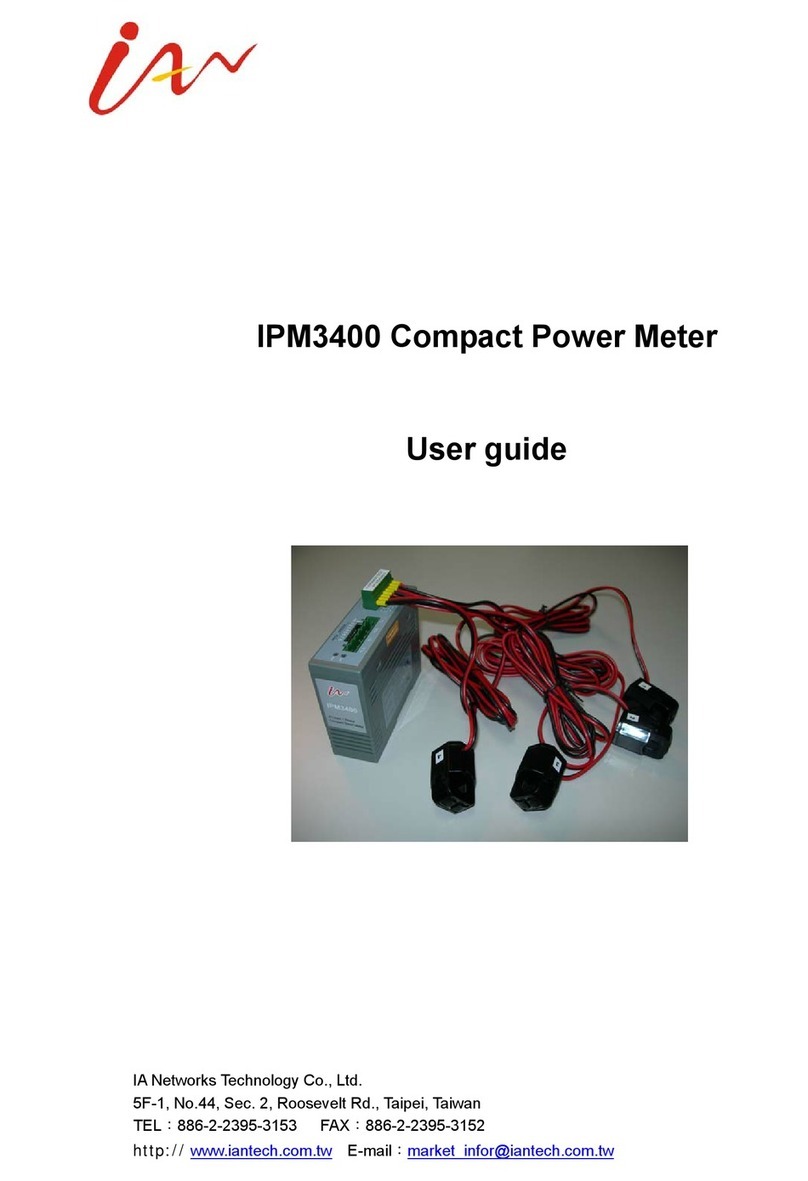
IA Networks Technology
IA Networks Technology IPM3400 user guide
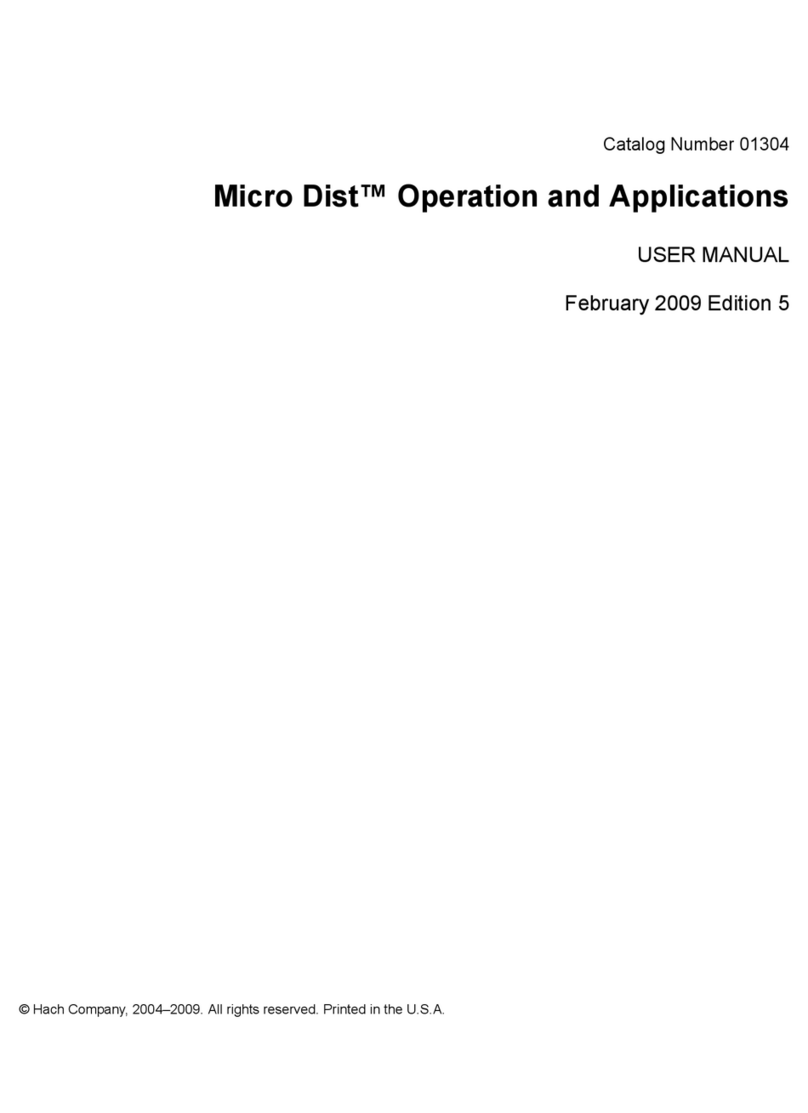
Hach
Hach Micro Dist Operation and application manual
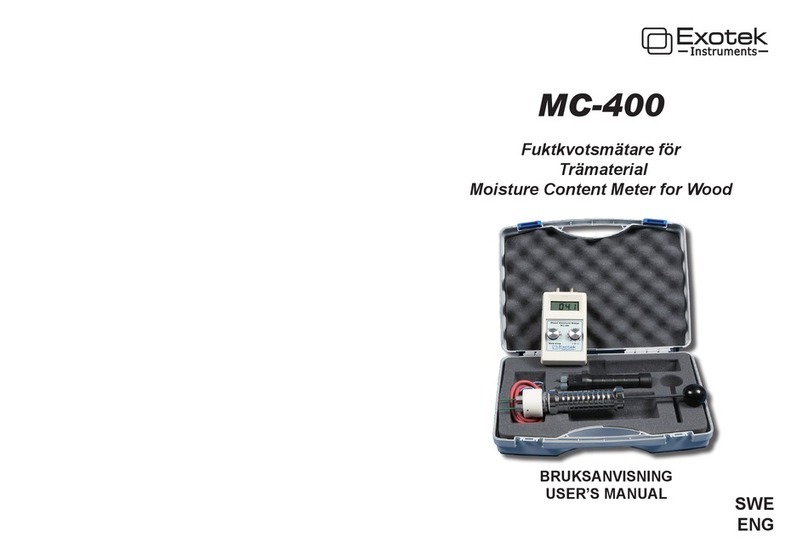
Exotek
Exotek MC-400 user manual

AMALGAMATED INSTRUMENT
AMALGAMATED INSTRUMENT PM5 Optional Output Addendum

